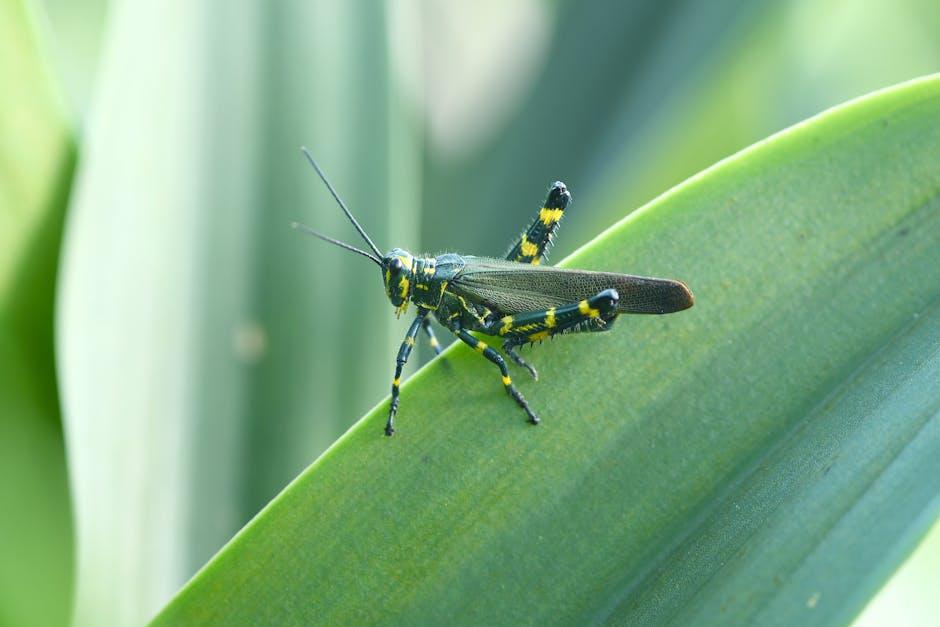Table of Contents
- Understanding Planetary Ecosystems and Their Importance
- Key Components of Planetary Ecosystems and Their Interactions
- The Role of Biodiversity in Maintaining Planetary Ecosystem Health
- Strategies for Protecting and Sustaining Planetary Ecosystems
- Exploring the Impact of Climate Change on Planetary Ecosystem Dynamics
- Q&A
- To Wrap It Up
Understanding Planetary Ecosystems and Their Importance
Planetary ecosystems encompass the intricate web of interactions between living organisms and their physical environment on a global scale. These systems are not confined to a single region; rather, they transcend borders and climatic zones, united by shared processes and exchanges of energy and nutrients. The significance of understanding these ecosystems lies in their ability to reveal the interconnectedness of life forms, from the smallest microorganisms to the largest mammals, and how they collectively influence the health of our planet.
At the heart of these ecosystems are critical components that sustain life, including:
- Biodiversity: The variety of species within different ecosystems plays a crucial role in maintaining ecological balance.
- Climate Regulation: Planetary ecosystems, such as forests and oceans, serve as significant carbon sinks, helping to regulate atmospheric temperatures.
- Resource Provisioning: They supply essential resources, from food and clean water to raw materials used in various industries.
- Cultural Values: Many ecosystems are vital to cultural identities and traditional practices, emphasizing the integral relationship between people and nature.
Moreover, understanding these ecosystems is vital for addressing global challenges like climate change, habitat destruction, and biodiversity loss. For instance, healthy planetary ecosystems contribute to:
| Benefits | Impact on Global Issues |
|---|---|
| Carbon Sequestration | Mitigates climate change by absorbing atmospheric CO2. |
| Water Filtration | Improves water quality and availability for diverse communities. |
| Soil Health | Enhances agriculture productivity and sustains food security. |

Key Components of Planetary Ecosystems and Their Interactions
The intricate web of planetary ecosystems is composed of several fundamental components that work together to sustain life. These include the physical environment, such as land, water, and atmosphere, which serve as the foundation for all biological interactions. Furthermore, the living organisms within these ecosystems—ranging from microscopic bacteria to towering trees—each play a unique role, further enriching the complex interactions vital for the ecosystem’s stability.
In addition to organisms, energy flow and nutrient cycling form the backbone of ecological interactions. Energy from the sun enters the ecosystem through photosynthesis, allowing plants to create food that supports herbivores, and subsequently carnivores. Moreover, the decomposition process facilitated by fungi and bacteria ensures that nutrients are recycled back into the soil, making them available again for plant uptake. This continuous cycle emphasizes the interdependence among various species, contributing to the overall health of the environment.
Understanding interactions within these systems often requires a closer look at their ecological relationships, such as mutualism, competition, and predation. These relationships can significantly impact the composition and functioning of ecosystems. For instance, mutualistic interactions—where both species benefit—can enhance biodiversity and resilience against environmental changes. In contrast, competitive and predatory interactions can help regulate populations, maintaining a balance essential for ecological sustainability.

The Role of Biodiversity in Maintaining Planetary Ecosystem Health
Biodiversity serves as the foundation for the intricate networks of life on Earth, playing a crucial role in sustaining planetary health. Each species, from the smallest microorganisms to the largest mammals, contributes to a complex web of interactions that bolsters ecosystem functionality. This rich variety of life ensures the resilience of ecosystems, allowing them to adapt to changes and challenges, such as climate fluctuations and habitat destruction.
Healthy ecosystems provide a multitude of essential services, including:
- Pollination: Many crops rely on various species for pollination, which is critical for food production.
- Carbon Sequestration: Diverse ecosystems like forests and wetlands absorb and store carbon, helping to mitigate climate change.
- Water Purification: Wetlands and forests filter pollutants, ensuring clean water for human consumption and wildlife.
When biodiversity diminishes, these vital services are compromised, leading to ecosystem instability and a decline in overall health. The loss of a single species can have a cascading effect, disrupting food webs and altering nutrient cycles. Therefore, protecting biodiversity is not just about conserving individual species, but also about sustaining the intricate relationships that bolstered the resilience and functionality of our planet’s ecosystems.

Strategies for Protecting and Sustaining Planetary Ecosystems
To effectively safeguard our planetary ecosystems, it is vital to implement a variety of innovative strategies that cater to both conservation and sustainability. One approach is the promotion of biodiversity through the establishment of protected areas. These areas serve as sanctuaries for various species, enabling them to thrive without the pressures of industrial activities. Furthermore, creating wildlife corridors allows for safe migration and communication among animal populations, which is crucial for genetic diversity. Key methods to enhance biodiversity include:
- Restoration Projects: Implementing reforestation and wetland restoration efforts to restore natural habitats.
- Community Involvement: Engaging local communities in conservation efforts fosters ownership and care for local ecosystems.
- Invasive Species Management: Developing programs to manage and control invasive species that threaten native flora and fauna.
Another effective strategy involves the adoption of sustainable practices that reduce the human footprint on ecosystems. This includes promoting the use of renewable energy sources, reducing waste through circular economy principles, and implementing sustainable agricultural methods. Transitioning to more sustainable food systems not only conserves natural resources but also enhances ecosystem resilience. Some successful tactics for sustainable practices include:
| Practice | Benefit |
|---|---|
| Agroforestry | Enhances biodiversity and soil health. |
| Organic Farming | Reduces chemical runoff and pollution. |
| Water Conservation | Preserves vital water resources. |
Lastly, education and public awareness play a pivotal role in ecosystem preservation. By informing people about the connections between environmental health and societal well-being, communities are empowered to take action. Programs aimed at fostering environmental stewardship can inspire global citizens to advocate for sustainable policies. Important components of effective educational initiatives include:
- Workshops and Training: Providing hands-on learning opportunities for communities.
- Social Media Campaigns: Utilizing digital platforms to spread awareness on conservation issues.
- Partnerships: Collaborating with NGOs to increase outreach and impact.

Exploring the Impact of Climate Change on Planetary Ecosystem Dynamics
Climate change significantly alters the intricate web of interactions that define our planet’s ecosystems. A shift in temperature can trigger profound effects, transforming habitats and influencing species survival. As temperatures rise, many organisms are forced to migrate in search of more favorable conditions, which can lead to a cascade of ecological changes. For instance, coral reefs, which are extremely sensitive to temperature fluctuations, experience bleaching events more frequently, resulting in the loss of biodiversity and disrupting the entire marine ecosystem they support.
Moreover, alterations in precipitation patterns contribute to soil degradation and water scarcity, affecting plant growth and the animals that depend on these plants for food. As arid regions expand and wet zones shift, the balance of flora and fauna is threatened. These changes can lead to new invasions by non-native species, which may outcompete local wildlife, further destabilizing ecosystem dynamics. The resulting impact on food chains can be dramatic, affecting both terrestrial and aquatic environments.
To understand these ongoing shifts, scientists employ various models and observations to predict potential future outcomes. This involves analyzing factors such as:
- Species distribution changes
- Altered carbon cycling
- Ecosystem service disruptions
By synthesizing data from multiple sources, researchers can begin to paint a comprehensive picture of how climate change is reshaping the natural world, enabling better conservation strategies and policy development aimed at preserving our planet’s rich biodiversity.
Q&A
Q&A on Planetary EcosystemsQ1: What is a planetary ecosystem? A: A planetary ecosystem refers to the intricate web of life that encompasses not only the biological entities—including plants, animals, and microorganisms—but also the physical environment and processes that interact with and support them. This includes the atmosphere, oceans, land, and climate of a planet, creating a closed-loop system where energy and nutrients flow, forming the foundation for life.Q2: How does a planetary ecosystem differ from a traditional ecosystem? A: While traditional ecosystems focus on localized systems, such as forests or wetlands, planetary ecosystems take a broader perspective. They consider the interactions and interdependencies across entire planets or celestial bodies. For example, Earth’s planetary ecosystem examines how atmospheric changes affect ocean currents, which in turn impact terrestrial life.
Q3: Why is understanding planetary ecosystems important? A: Understanding planetary ecosystems is crucial for several reasons. First, it helps us comprehend how life evolved and thrives in various environments, including extreme conditions. Second, this knowledge aids in developing strategies for conservation and sustainable practices on Earth and informs our search for life on other planets by identifying the necessary conditions for life as we know it.
Q4: What factors influence planetary ecosystems? A: Planetary ecosystems are influenced by a variety of factors, including climate, geological activity, and the presence of water. Additionally, human activities, such as pollution and deforestation, significantly impact Earth’s ecosystem dynamics. For extraterrestrial ecosystems, factors like solar radiation, atmosphere composition, and gravity also play critical roles in determining what forms of life, if any, can exist.
Q5: Can planets with no life still have a planetary ecosystem? A: Yes, a planet can possess a form of planetary ecosystem even without life. For instance, a planetary ecosystem can include the physical and chemical processes that govern the interactions between different elements, such as the carbon cycle in carbon-rich environments or the water cycle on a planet that features liquid water. These processes create dynamic systems that, while lifeless, still demonstrate ecosystem-like characteristics.
Q6: How does climate change affect planetary ecosystems? A: Climate change poses significant threats to planetary ecosystems, particularly on Earth. Rising temperatures, shifting precipitation patterns, and extreme weather conditions can disrupt the delicate balance of ecosystems. These changes can lead to species migration, habitat loss, and altered food webs. As these systems are interconnected, disturbances in one area can trigger a chain reaction impacting biodiversity and ecological stability.
Q7: What is the future of studying planetary ecosystems? A: The future of studying planetary ecosystems is bright, as advancements in technology and space exploration offer unprecedented opportunities for discovery. Scientists are increasingly investigating other celestial bodies, like Mars and the icy moons of Jupiter and Saturn, to understand the potential for extraterrestrial ecosystems. On Earth, interdisciplinary approaches combining biology, geology, and climate science are essential for developing strategies to combat ecological threats and protect our diverse planetary ecosystem.—This Q&A format aims to inform readers about planetary ecosystems in an engaging and accessible way, fostering a deeper understanding of this fascinating and essential topic.



0 Comments